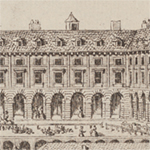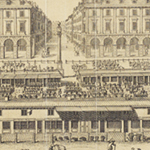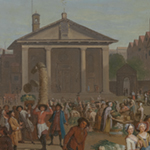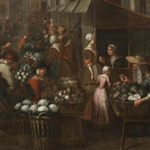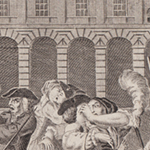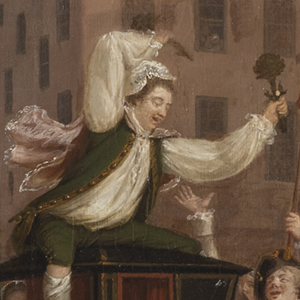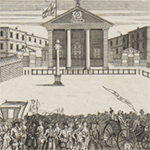Covent Garden
Names
- Covent Garden
- Covent Garden Market
- Convent Garden
- Covent Garden Square
Street/Area/District
- Covent Garden
Maps & Views
- 1553-9 Londinum (Braun & Hogenberg, 1572): Covent Garden
- 1553-9 London ("Agas Map" ca. 1633): Covent Garden
- 1560 London (Jansson, 1657): Covent Garden
- 1593 Westminster (Norden, 1653): Convent Garden
- 1600 Civitas Londini - prospect (Norden): Convent garden
- 1658 London (Newcourt & Faithorne): Piatzo
- 1690 (-1790) Covent Garden (Crowle): Covent Garden
- 1690? Londini (Ram): Piazzo
- 1710 Prospect of the City of London, Westminster and St. James' Park (Kip): Covent Garden
- 1720 London (Strype): Covent Garden
- 1725 London map & prospect (Covens & Mortier): Covent Garden
- 1736 London (Moll & Bowles): Covent Garden Market
- 1746 London, Westminster & Southwark (Rocque): Covent Garden Market
- 1761 London (Dodsley): Covent Garden Market
- 1799 London (Horwood): Covent Garden
Descriptions
from A New View of London, by Edward Hatton (1708)
Covent Garden, a pleasant Square, on the NW and NE sides, whereof, are very stately Buildings, partly elevated on large Pillars, which makes very fine Piazzas. On the SW side is the Church, and on the SE the Market for Earthenware, Fruit and Herbs; the Area is 3 Acres, and the Column in the Center, is from Cha+ [Charing Cross] NWly, 670 Yds.
from A Survey of the Cities of London and Westminster, by John Strype (1720)
Covent Garden Square. The Ground on which this [Covent Garden] Parish is built, was formerly Fields, with some thatched Houses, Stables, and such like, which lying in so good a Place, the Owner of the said Ground, (the Earl of Bedford) did think good to make an Improvement thereof, and procuring an Act of Parliament for the making it into a Parish of itself, disunited from St. Martin's in the Fields, did, about the Years 1634, and 1635, begin to pull down the said old Buldings, and clear away the Rubbish, and laid it out into several fair Streets, streight and uniform, which were built with good brick Buildings. About the Centre of the Ground, he caused to be set out a large Square, or rather oblong Piece of Ground, 500 Foot in Length, and 400 in Breadth; and into this Plot of Ground, four large Streets of about 50 or 60 Foot broad, have their Entrance, viz. Russel-street on the West, James street on the North, King's street, and Henrietta street on the West, and the South Side is taken up by the Wall of Bedford Garden: On the North and East Sides are erected stately Buildings for the dwelling of Persons of Repute and Quality, their Fronts standing on Pillars and Arches of Brick and Stone Rustick Work, with Piazzas, or Walks, like those in the Royal Exchange in London, and imitating the Rialto in Venice. Since the first Building, this Parish hath had great Improvements, as well by its Houses as its Inhabitants.
from Lockie's Topography of London, by John Lockie (1810)
Covent-Garden,—the N. end of Southampton-st. from 387, Strand, or the S. end of James-st. from 43, Long-acre.
from A Topographical Dictionary of London and Its Environs, by James Elmes (1831)
Covent Garden is a large quadrangle, situated between the Strand and Long-acre, with Inigo Jones's fine church of St. Paul on its western side and Russell-street on its eastern. It contains within its spacious area, a new and commodious market, built at the expense of the Duke of Bedford, its ground landlord, by William Fowler, Esq., most substantially erected with granite columns and other durable materials.
This district of the metropolis derives its name from having been formerly a garden belonging to the abbot and monks of the Convent of Westminster, whence it was called Convent and by corruption Covent Garden. At the dissolution of the religious houses, it was given to Edward Duke of Somerset, but on his attainder, it again reverted to the crown, and Edward VI. granted it, in 1552, to John, Earl of Bedford, together with a field called the Seven Acres, which being built on for a street, was, from its length, called Long-acre.
Covent Garden, would have been, if completed according to Inigo Jones's design, one of the finest squares or places (it is called Piazza, the Italian for place) in Europe. The proportions of the arcades and piers, crossed with elliptical and semi-circular arches into groins, are exquisitely beautiful, and are master-pieces of architecture.
from London Past and Present: Its History, Associations, and Traditions, by Henry Benjamin Wheatley and Peter Cunningham (1891)
Covent Garden, properly Convent Garden, and so called from having been originally the garden of the Abbey at Westminster.
It is so described in an Inquis. after the decease of one Robert Reed, of the parish of St. Martin-in-the-Fields, Gent, (taken on 2 August, 9 Elizabeth), who is thereby stated to have held of the Dean and Chapter of the Collegiate Church of Westminster, some messuages with gardens thereto, "scituantur inter regiam viam ducentem de Charinge Crosse usque Londinum ex parte Australi et gardinum nuper pertinens Monasterio Sancti Petri Westmonasteriensis vocatum le Covent Garden ex parte boriali, et abuttant super terram monasterii de Abingdon versus occidens." Then by an Inquis. taken after the decease of Francis, Earl of Bedford, on 29 Decr., 28 Eliz., it was found that he held "I acras terre, et pasture, cum pertinentiis vocat' The Covent Garden jacentes in parochia Scî Martini in campis juxta Charinge Crosse in Com' Midd' ac vii acras terre et pasture vocat' The longe acre adjacentes prope Covent Garden in parochia predictâ."—T. Edlyne Tomlins, MS. communication.
This Covent Garden and the lands belonging to it was first granted by Edward VI. to his uncle the Duke of Somerset; which upon his attainder came back to the Crown. And then in the month of May, 1552, there was a patent granted to John, Earl of Bedford, of Covent Garden, lying in the parish of St. Martin's-in-the-Fields, next Charing Cross, with seven acres called Long Acre, of the yearly value of £6 : 6 : 8, parcel of the possessions of the late Duke of Somerset, To have to him and his heirs, to be held in Soccage and not in Capite.—Strype, B. vi. p. 88.
In the Archaeologia (vol. xxx. p. 494) is a copy of a lease from the Earl of Bedford to Sir William Cecil, dated September 7, 1570, of "all that his porcyon or percell of grounde lyenge in the East Ende, and being percell of the Enclosure or Pasture communely called Covent Garden, scituate in Westm', which porcyon the said Sr Willm Cecill doeth and of late yeares hath occupied at the sufferaunce of the said Earl, and hath bene and ys now dyvyeded from the rest of the said enclosure called Covent Garden, on the west syde of the said porcyon or p'cell nowe demysed wth certain Stulpes and Rayles of Wood, and is fensed wth a wall of mudde or earth on the East next vnto the Comune highwaye that leadeth from Stronde to St. Giles in the fyeldes, and on the west end towardes the South is fensed wh the Orchard wall of the said Sr Willm Cecyll, and on the South end with a certayne fence wall of mudde or earth, beinge therbye devyeded from certaine Gardens belonginge to the Inne called the Whyte Heart [see Hart Street], and other tenementes scituate in the high streate of Westm', comunly called the Stronde." The Sir William Cecil of the lease was the great Lord Burghley.1 Later Cecil appears to have been desirous to buy the property.
April 27, 1610.—Edward, Earl of Bedford, writes to the Earl of Salisbury that he cannot sell him his inheritance of Covent Garden, having bound himself under a heavy penalty not further to impoverish himself by sale of his property.—Cal. State Papers, 1603–1610, p. 604.
August 17, 1611.—John Dacombe informs Cecil that the Earl of Bedford has conveyed Covent Garden in trust for the present maintenance of the Countess, who will transfer to his Lordship [evidently Salisbury] the things desired by him.—Cal. State Papers, 1611–1618, p. 69.
Covent Garden, particularly so called, is the large and well-proportioned square (or piazza) in which the Market stands; with the arcade or (so-called) piazza on the north side, and the church of St. Paul's, Covent Garden, on the west. Tavistock Row, which stood on the south side, has been entirely pulled down. The arcade on the north-east side has been pulled down and the Hummums Hotel on the south-east side rebuilt. The west portion of the north side was rebuilt about 1880. The square was formed (circa 1631) at the expense of Francis, Earl of Bedford (d. 1641), and from the designs of Inigo Jones2 (d. 1652). The arcade or piazza ran along the whole of the north and east sides of the square; the church completed the west; and the south was finished by the wall of Bedford House garden and a grove or "small grotto of trees most pleasant in the summer season,"3 and under which the first market was originally held. The east side south of Russell Street was called the Little Piazza, but after the fire of 1769 the houses were rebuilt without the arcade. In the centre of the square was a column surmounted by a dial (but this was subsequent to Inigo's time4), and the whole area was laid with gravel, and dry and well kept The scene of Dryden's Sir Martin Mar-All is laid in this once fashionable quarter of the town, and so also is that of the pleasant comedy, Sir Courtly Nice, or It cannot be, 4to, 1685. The allusions to the square, the church, and the piazza are of constant occurrence in the dramas of the age of Charles II. and Queen Anne. The allusions are, however, for the most part to the loose morality of those who dwelt in Covent Garden, and the libertinism of those visitors; and Kit Smart's Epilogue to the Lying-in Hospital, written in 1755, and spoken by Shuter, shows that, even as late as the middle of the last century, almost any coarseness would be tolerated in reference to Covent Garden. Among the now happily scarce publications, for which collectors of miscalled facetiae readily give long prices, are Harris's Lists of Covent Garden Ladies, published annually from about 1760 to nearly the end of the century.
This town two bargains has not worth one farthing,
A Smithfield horse—and wife of Covent Garden.
Epilogue to Dryden's Limberham.
Come, come, do not blaspheme this masquerading age, like an ill-bred city-dame whose husband is half-broke by living in Covent Garden.—Wycherley, The Gentleman Dancing-Master, 4to, 1673.
'Slife! I'll do what I please. A great piece of business to go to Covent Garden Square in a hackney coach, and take a turn with one's friend! If I had gone to Knightsbridge, or to Chelsea, or to Spring Garden, or Barn Elms, with a man alone something might have been said!—Congreve, Love for Love, 4to, 1695.
Where Covent Garden's famous temple stands,
That boasts the work of Jones' immortal hands,
Columns with plain magnificence appear,
And graceful porches lead along the square;
Here oft my course I bend, when lo! from far
I spy the furies of the foot-ball war:
The 'prentice quits his shop to join the crew,
Increasing crowds the flying game pursue.
O whither shall I run? the throng draws nigh;
The ball now skims the street, now soars on high;
The dexterous glazier strong returns the bound,
And jingling sashes on the pent-house sound.
Gay, Trivia.
As the Exchange is the Heart of London; the great Hall, and all under the contiguous roofs the Heart of Westminster; so is Covent Garden the Heart of the Town. The intelligent very well know that many have got estates both in London and Westminster and died in these Cities that could never get into Town.—Steele, Town Talk, No. 1.
You remember I told you in my first that Covent Garden is the Heart of the Town, and by that rule the Play House is the Town Hall.—Steele, Town Talk, No. 5.
The Lady Wortley Montagu, who has been greatly indisposed at her house in Covent Garden for some time, is now perfectly recovered, and takes the benefit of the air in Hyde Park every morning by advice of her physicians.—Morning Advertiser, March 1, 1730.
Covent Garden was made a parish by ordinance of January 7, 1645, confirmed by an Act of 12 Charles II., anno 1660. It is encompassed (curiously enough) by the parish of St. Martin's-in-the-Fields.
Many of the residences of eminent men in this interesting locality are described elsewhere. [See Bedford Street; Bow Street; Charles Street; Henrietta Street; King's Coffee-house; King Street; Piazza; Russell Street; St. Paul's Church; Tavistock Row, etc.]
Evans's Hotel, at the west end of the piazza, was built for Russell, Earl of Orford, the English admiral who defeated the French off Cape La Hogue. The Earl died here in 1727. People are found who see a fancied resemblance in the facade of the house to the hull of a vessel. The fine old staircase was formed of part of the vessel commanded by Admiral Russell at La Hogue—the Britannia, 100 guns. It is handsomely carved with anchors, ropes, etc., coronet and initials of Lord Orford. Lord Orford left his house to Archer, afterwards Thomas, Lord Archer (d. 1768). James West, the great collector of books, etc., and president of the Royal Society (d. 1772), father-in-law of Lord Archer, lived in the house during that nobleman's life. In January 1774 it was opened by David Low as an hotel; the first family hotel, or Hotel Garni, as Walpole terms it,5 established in London. It was long famous as Evans's supper rooms, and is now (1889) occupied by the New Club.
1 In 1627 only two people were rated to the poor of the parish of St. Martin's-in-the-Fields under the head "Covent Garden."
2 They show, at Wilton, Inigo's coloured designs for the piazza of Covent Garden and the square of Lincoln's Inn.
3 Strype, B. vi. p. 89.
4
| 1668. Dec. 7. | Received of the Right Honourable the Earle of Bedford, as a gratuity towards the erecting of ye Column | £ s. d. 20 0 0 |
| Ditto. | Received from the Honourable Sr Charles Cotterell, Master of the Ceremonys, as a gift towards the said Column | £ s. d. 10 0 0 |
| 1669. Ap. 29. | Received from the Right Honourable the Lord Denzill Holles, as a present towards the erecting of the aforesaid Column | 10 0 0 |
| 27 Nov. 1668. | For Drawing a Modell of the Column to be presented to the Vestry | 0 10 0 |
| 2 Dec. 1668. | To Mr. Wainwright for the 4 Gnomens | 0 8 6 |
Churchwardens' Accounts of St. Paul's, Covent Garden.
5 Walpole to Mann, March 11, 1776.
